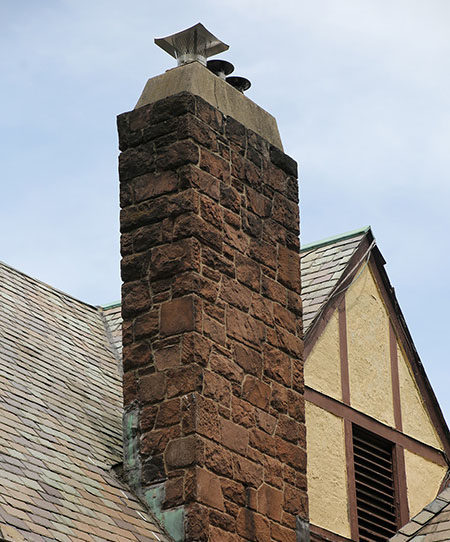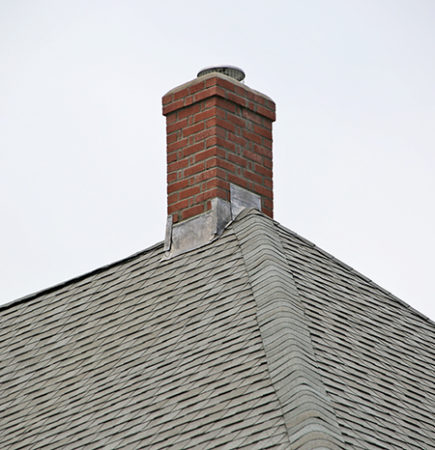What Should You Do If Your Chimney Is Damaged by a Storm?
 We often receive a high volume of service calls after a powerful storm has swept through Central Connecticut. Since the chimney is the highest point at the top of a house, it is the most likely to be damaged by high winds, heavy rain or lightning during a storm. Small problems caused by a storm like a missing chimney cap, cracked bricks or loose flashing can lead to bigger problems if they aren’t fixed quickly.
We often receive a high volume of service calls after a powerful storm has swept through Central Connecticut. Since the chimney is the highest point at the top of a house, it is the most likely to be damaged by high winds, heavy rain or lightning during a storm. Small problems caused by a storm like a missing chimney cap, cracked bricks or loose flashing can lead to bigger problems if they aren’t fixed quickly.
A common result of unrepaired storm damage is a leaky chimney or roof that causes water damage to ceilings, walls and structural beams. Water damage in and around the chimney can also deteriorates the structure of the chimney making it unstable and unsafe to use. Where there is water, there is often mold. The best way to avoid the risk of toxic mold growing in your home or expensive repairs to the chimney system, walls, ceiling or other structural components of your home, is to check for damage after a storm and act quickly if you notice any.
You can usually spot signs of storm damage to the chimney by doing a simple visual inspection. Here’s what to look for after a storm:
#1 – Water marks around the molding on your fireplace or bad flashing on the roof. One of the easiest ways for water to enter your home is by seeping through the gap between the chimney and the roof. That is why it is important to have good flashing that seals the joint between the two. Flashing is a water-resistant barrier, usually made of galvanized metal, rubber or plastic that seals joints on the outside of your home. If you notice discoloration, or water marks, around the molding on your fireplace, it is a strong indicator that the chimney flashing needs to be repaired or replace. By stepping outside and taking a look at your chimney, you might be able to spot problems with the flashing before any water damage is noticeable inside. If the joint between the chimney and roof is visible, you should be able to see if it looks like the flashing is loose or broken.
#2 – A dislodged or damaged chimney cap or chase cover. Water can also enter your home directly through the chimney. That is why chimney caps or chase covers are installed. Chimney caps are made for traditional masonry fireplaces. Chase covers are made for pre-fabricated fireplaces. Both are made of rust-resistant metal and mesh, and are installed at the top of the chimney to prevent rain water, snow and pests from entering the chimney. Though they are made to endure harsh weather, they can be damaged or dislodged during a severe storm. When you take a look at your chimney, you should see a metal hat at the top. If it is askew, missing, or looks like it has a hole or other damage, it should be repaired or replaced. If your chimney has never had a chimney cap or chase cover, it is wise to have one installed.
#3 – Cracks in the masonry or chips of masonry on the ground near the chimney. Visible damage to the bricks and mortar of the chimney is a warning sign of structural damage. This damage may be caused by impact from debris during a storm with high wind speeds or from water seeping into the chimney system. Whether the cause is external (debris) or internal (water), the problem will multiple if the bricks and mortar are not repaired. Cracks and gaps in masonry allow moisture to seep in which will deteriorate the mortar joints and weaken the bricks. This can destabilize the chimney walls and damage the flue lining. Using a fireplace with a damaged flue lining increases the risk of a house fire. If the flue lining is broken or warped, it can create pathways for stray sparks to reach flammable materials like structural beams, insulation and drywall. It is very important to have the chimney and flue lining inspected, if you notice cracks in the masonry or find pieces of masonry in the fireplace or around the chimney, to assess the problem and have the masonry repaired before the damage increases.
#4 – Efflorescence, or chalky white salt deposits, on the chimney. Discoloration of bricks can be more than just an eye sore. If you notice chalky white spots on the chimney, it is a sign that the masonry is absorbing water. The discoloration, known as efflorescence, is caused by salt that is drawn to the surface when water evaporates out of the brick. If enough water is evaporating out of the brick to cause staining, it may also be damaging the structural integrity of the chimney. The chimney will need to be inspected to discover how water is getting in and how much damage has been caused. The solution may be as simple as having the chimney treated with a water-proofing sealant.
 Did you spot one of these signs when you inspected your chimney? If so, you should contact a qualified chimney technician to set up a chimney inspection! Chimney experts like us have the training, experience and equipment to safely and thorough assess your chimney, recommend the best solution and fix the problem. Give our team a call if you are located in Central Connecticut! The qualified chimney experts on our team at Northeastern Chimney, Inc. serve customers from West Hartford and Farmington to Windsor and Bloomfield and beyond. We know the ins and outs of chimney maintenance and repairs. We can help you whether your chimney needs a new chimney cap, waterproofing, flashing repair or masonry restoration.
Did you spot one of these signs when you inspected your chimney? If so, you should contact a qualified chimney technician to set up a chimney inspection! Chimney experts like us have the training, experience and equipment to safely and thorough assess your chimney, recommend the best solution and fix the problem. Give our team a call if you are located in Central Connecticut! The qualified chimney experts on our team at Northeastern Chimney, Inc. serve customers from West Hartford and Farmington to Windsor and Bloomfield and beyond. We know the ins and outs of chimney maintenance and repairs. We can help you whether your chimney needs a new chimney cap, waterproofing, flashing repair or masonry restoration.


